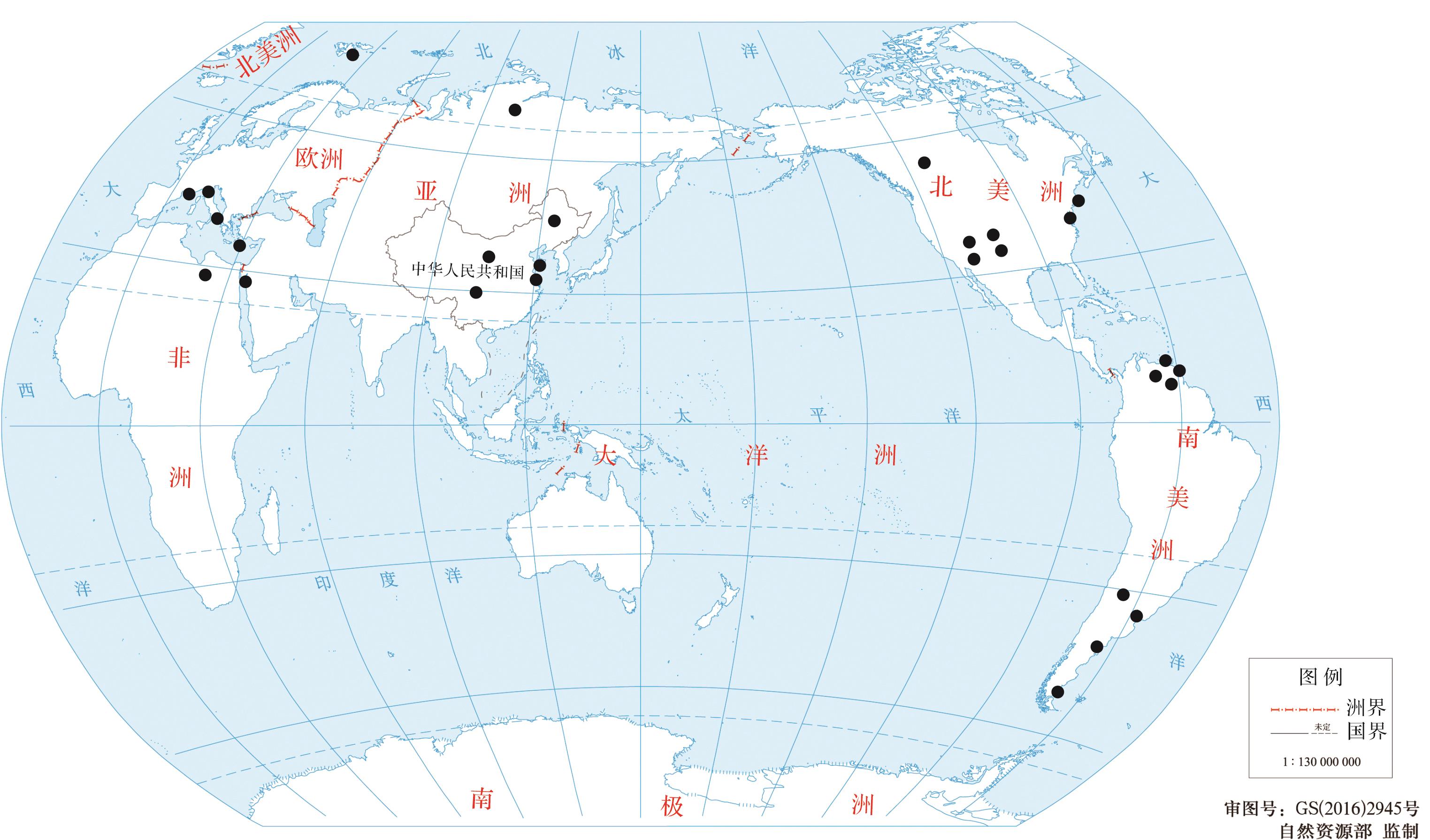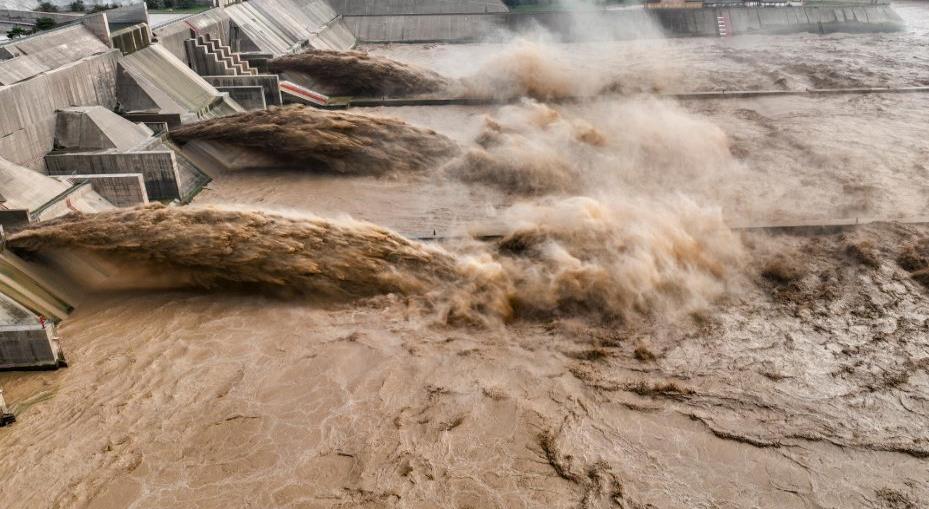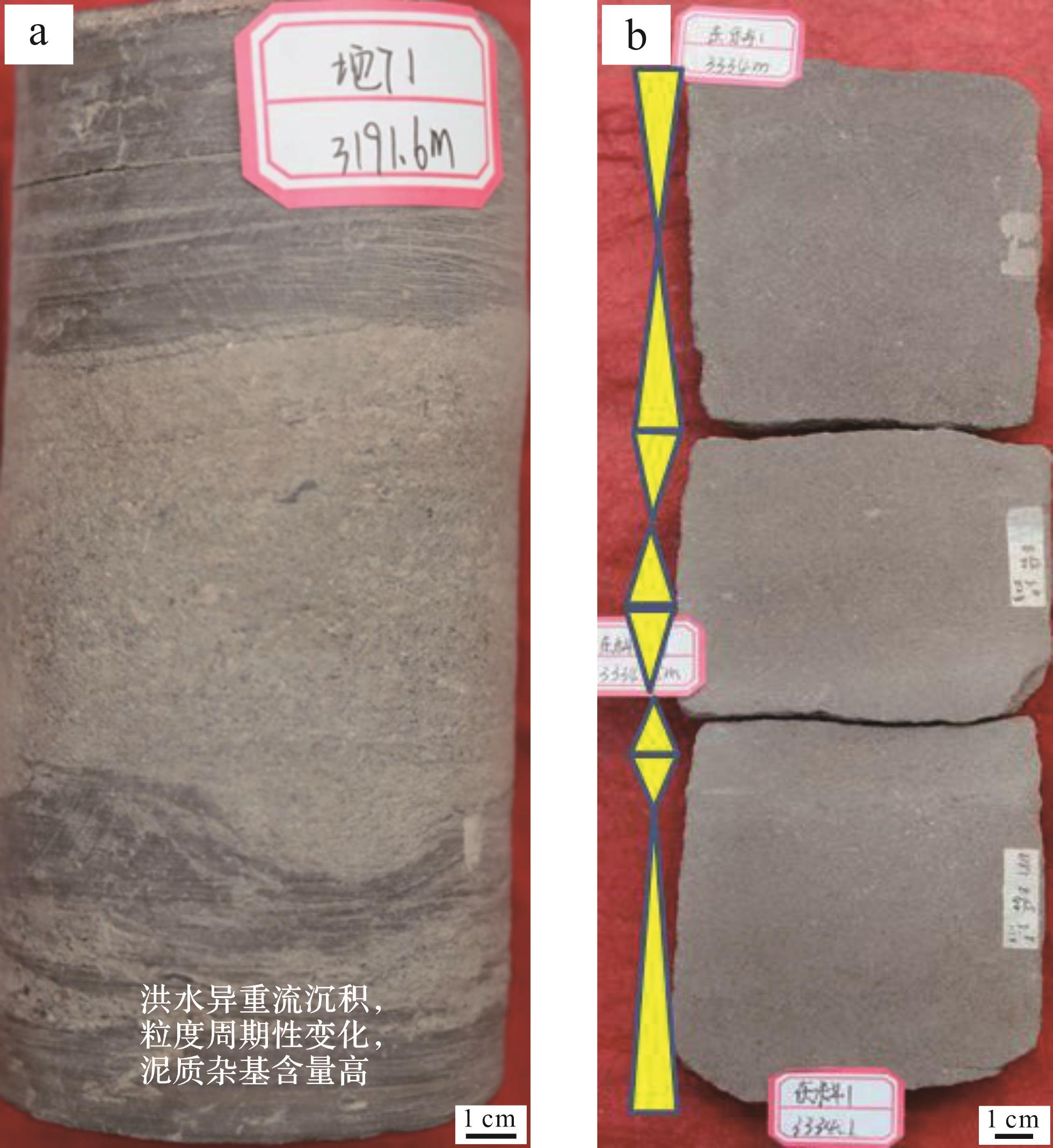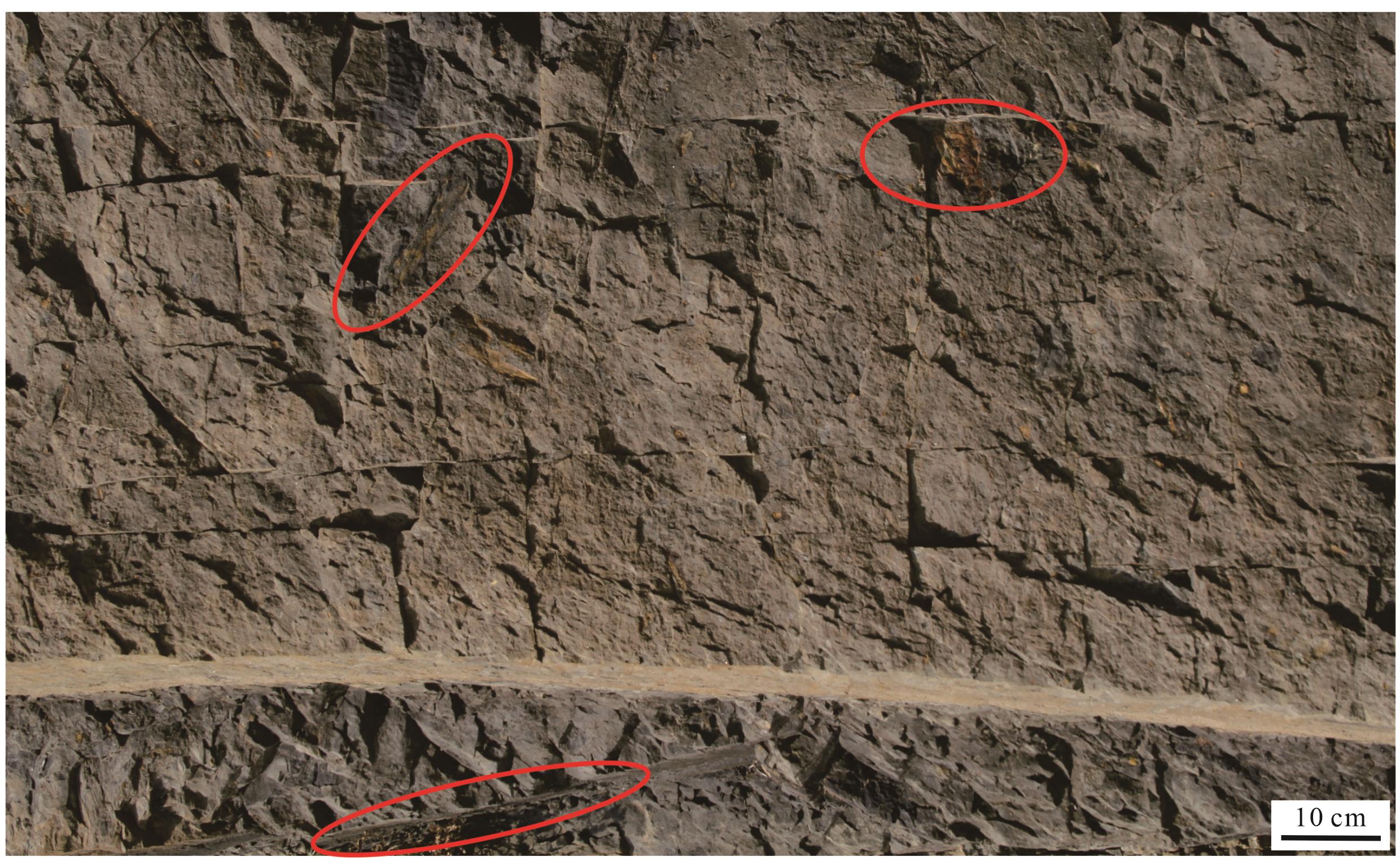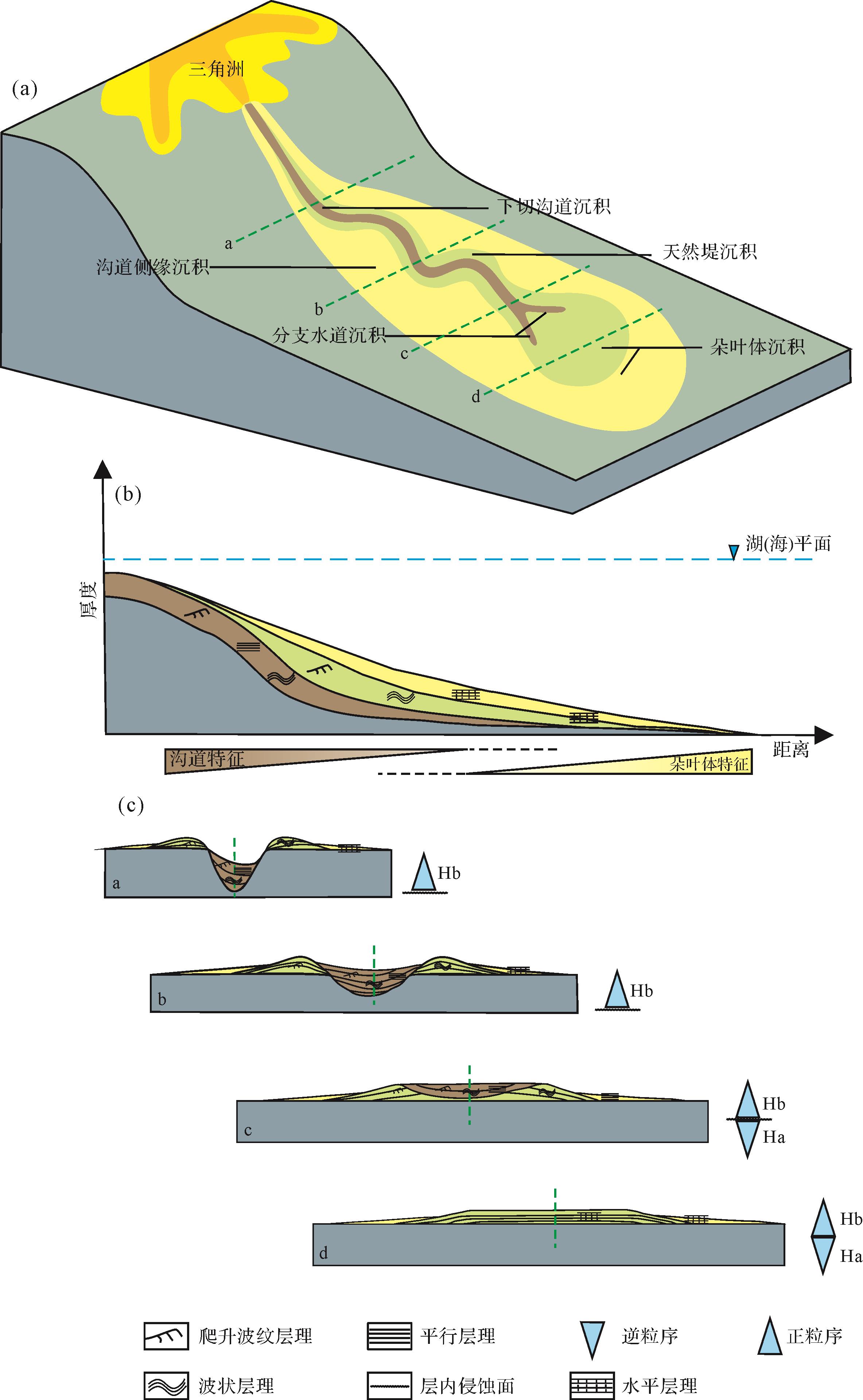HTML
-
作为一种将陆源碎屑物质进行远距离搬运的沉积流体类型,异重流相关的研究取得了诸多进展,为全面理解海洋和湖泊环境中的沉积机制提供了新的视角。通过对古代和近代沉积的观测研究、海洋学观测、水槽实验和数学建模等,人们对异重流及异重岩(hyperpycnites)的理解已不断趋向深入[1]。异重流沉积研究可以指示古构造[2⁃3]、古地形[4⁃6]、古流水活动[7]、古气候[2,8]、古生物类型[3,9⁃10]等地质信息。研究异重流的触发因素、持续时间以及演化过程,对于理解沉积物的远距离搬运机制、预防破坏网络电缆[11]以及指导水利工程的空间资源利用和延长使用寿命[12⁃13]等至关重要。
作为一种将沉积物向盆地搬运的重要机制,异重流沉积及其油气地质意义的研究亟待加强[14]。异重流不仅可以形成分布广泛的沉积砂体和潜在的油气储集层[15],而且异重流携带大量陆源有机质和营养物质进入深水区,对烃源岩的形成产生影响[16]。相较于海相环境,陆相湖盆更易发生异重流沉积[17],对于湖相常规油气和非常规油气勘探开发均具有重要的指导意义[17],异重流沉积在油气地质方面的进展受到越来越多学者的关注[14⁃15,18⁃20]。
虽然异重流沉积研究取得了重要进展,但针对不同相带、不同沉积背景条件下的异重岩鉴定标志亟待明确,故本文介绍了异重流的概念及发展历程,分析了异重流发育条件和影响因素,研究了异重流的沉积特征和判识标志;并展望了未来异重流沉积的发展方向与趋势,以期为异重流有关的研究提供参考。
-
异重流(hyperpycnal flow)是一种源自洪水期河口、受重力驱动而沿沉积盆地的底部流动、以准稳态存在的高密度沉积物重力流。异重流现象最早发现于日内瓦湖[21]。1950年,Kuenen认为浊流是形成粒序层理的主要原因[22],水下重力流沉积研究得以发展[23⁃24]。Bates[25]首次提出异重流的概念并观察到水下浊流向海方向运动时表现出三种不同的类型,分别命名为异轻流(hypopycnal flow)、等重流(homopycnal flow)和异重流(hyperpycnal flow)。后来,Mulder et al.[26]进一步提出了“层间流”(mesopycnal flow)的概念,更为详细地划分了河流高密度流体进入盆地水体中表现的几种流入类型(图1)。
河流的大洪水事件导致频繁的异重流现象产生[28],通过对瓦尔河的长期观测[29],认为洪水河流对于触发重力流具有重要作用,也是将陆源沉积物输送到深海海底的一个重要机制[30⁃32]。Mulder et al.[33]研究认为异重流在中小型河流的河口更易引发异重流。含悬浮泥沙河水的密度与海水(湖泊)的密度差决定异重流能否产生[33⁃34]。当河流高密度流体以36~43 kg/m3的悬浮物含量排入海洋时[35],会形成海洋异重流。但对于淡水湖盆而言,在河口向淡水湖中产生异重流所需的临界浓度要低得多(<<1 kg/m3)[4,32]。Zavala et al.[36]认为由洪水中河流直接输入的高密度水流引起的,将其沉积产物称为盆外浊积岩;而将由斜坡滑塌型浊流沉积的产物称为盆内浊积岩。
受国外异重流研究进展[5,14⁃15,28]和国内相关成果的启发[37],在我国中新生代陆相地层中陆续发现异重流沉积[17,38⁃40],通过测井数据分析和岩心观察,发现平行层理、波纹和槽状交错层理等构造特征以及植物碎片、碳质碎屑等有机质证据,且发现在扇体远端沉积物颗粒较粗,随着沉积过程演化,近端粒度逐渐减小。认为大型坳陷湖盆同样具备形成异重流的条件,对于判断异重岩储集性能和分析油气生成的有机物来源,以及非常规油气地质研究方面具有指导意义[38]。近年来异重流相关研究也逐渐被重视(表1),世界各地的海洋和湖泊环境中产生的异重流现象逐渐被发现(图2)。一些学者在我国鄂尔多斯盆地延长组[38]、松辽盆地嫩江组[39]、渤海湾盆地沙河街组[32]、和青岛灵山岛组[41]等发现异重流沉积且进行了详细的研究(图2)。
作者 时间 代表成果 参考文献 Forel 1885年 首次发现并研究异重流现象 [21] Kuenen et al. 1950年 认为浊流形成粒序层理 [22] Bates 1953年 将向海流入流体命名为异轻流等重流和异重流并给出异重流定义 [25] Wright et al. 1988年 提出高密度异重流和低密度异重流 [24] Mulder et al. 1995年 进一步完善异重流定义 [33] Khripounoff et al. 2009年 认为异重流是将陆源沉积物输送到深海的重要机制 [29] 何起祥 2010年 介绍了异重流的概念,指出异重流较高的发生频率 [37] 杨仁超等 2015年 在坳陷湖盆中发现异重岩,认为陆相淡水湖盆有利于异重流的产生 [17] Zavala et al. 2016年 提出将异重流产生的沉积物命名为盆外浊积岩 [36] 
Figure 2. Global distribution of case studies of hyperpycnal flow deposition[42]
-
当悬浮泥沙的浓度非常大,以至于河水的密度大于海(湖)水的密度并达到产生异重流所需的临界浓度,便在河口三角洲处形成异重流现象,同时可能侵蚀海(湖)底,形成下切水道。研究结果表明,中小河流更容易在河口触发高密度底流。世界上至少有九条“脏水”河流可能在一年内引发异重流[33](表2);其他大多数河流只有在洪水期间才可能产生异重流。由于其广阔的沿海洪泛区内的泥沙滞留,有效地降低了悬浮浓度,沉积物容易发生卸载[43],故大型河流不易在河口产生高密度底流。含悬浮泥沙河水的密度与海水(湖泊)的密度差异是产生异重流的决定性因素[33⁃34]。
盆地水体性质 质量分数/% 体积分数/% 平均密度/kg·m-3 悬浮物密度/kg·m-3 海水 >3.4~4.7 >1.30~1.74 >1 022~1 027 >35~45 淡水 >0.1 >0.04 >1 000 >1 当淡水河流以36~43 kg/m3的悬浮物含量排入海洋时,会形成海洋异重流[35]。而在淡水湖中产生异重流所需的临界浓度要低得多(<<1 kg/m3)[4,32]。然而,Parsons et al.[44]通过实验发现,当河流悬浮物浓度达到1 kg/m3以上,便可以在海洋中形成异重流;若考虑对流不稳定性的情况下,当悬浮物浓度为1~5 kg/m3时,在海洋环境中就会形成异重流。可见在不同环境条件下,产生异重流的密度阈值也不尽相同。
-
异重流具有长期持续流动的特点,单次完整的洪水型异重流也被称为准稳定型流体(又称持续性流体)[30,45],一般准稳定型流体可持续几天,甚至达数月。因此,蓄水盆地的水体足够深,有利于异重流的发生,在某些情况下超过几十米,河流浊流水体才能有足够的地质营力沿着盆地底部流动并形成异重流,并持续地以一定流动速度(通常小于2 m/s)向盆地中心流动。通常深度较大的陆相湖盆更有利于异重流的形成,如洱海、邛海等内陆湖泊均产生异重流及其沉积[46]。但异重流发生的蓄水盆地水深阈值与注入的洪水流量相关,在洪水流量较小(密度较大)的情况下,即使盆地的水深较浅,也可能发生异重流。
-
异重流的形成易受极端事件的驱动,如火山泥流[35,47]、冰川融化[48⁃49]、台风和海啸[7]以及人工堤坝破裂[50]和水库排水[35]等(图3)。Mulder et al.[51]归纳总结了六种异重流形成的环境条件:(1)干旱的季节性洪泛地区;(2)人工堤坝破裂或排水;(3)台风等极端事件引起的中小河流洪水;(4)冰川融化和融雪性洪水;(5)黄土高原洪泛性泥石流;(6)火山泥流等特殊地质条件。因此,随着水土流失造成的土地沙漠化以及碳排放产生的温室效应引起的冰川融化和融雪性洪水,会导致异重流更加频繁地发生。
-
针对全球河流的统计显示,将近71%的河流具备形成异重流的可能性[33]。河口异重流的产生会受到诸多因素的共同作用,如地形地势[30,50,52⁃53]、物源区沉积物供给[30,53⁃54]、河流流域规模[30]、形成的浊流与入海(湖)水体密度差、气候导致的地区环境因素(干旱/半干旱/湿润)[8,55]和季节性降水[44]引起的洪泛现象、海(湖)平面上升/下降[55⁃60]、强烈的构造活动[53,61⁃62]、洪水发生的流量和频率[35,62]等诸多因素有关,但主要取决于构造、气候、地形及物源等主导因素。
-
构造活动是控制盆地形成与发育演化的主导因素,它控制了物源区的隆升、盆地的沉降过程与幅度、盆山耦合与差异升降、沉积环境演化与沉积相带迁移、古地理格局、可容纳空间的变化等。构造活动与古气候一道,从根本上影响古地形地貌、物源供给与沉积充填演化。构造影响地形坡度[5,59]、盆地水体深度[63⁃64]以及河流高密度流体与盆地水体高度差[30]。盆地的构造活动或伴随的古地理重组通过改变波浪与河流能量的相对平衡,有利于富含浊积岩的陆架沉积物的生成[61]。由于物源区或盆地边缘的构造抬升,侵蚀和泥沙供应率增加,增加了海岸线沿线河流占主导地位的可能性,并增加河流高密度流体与盆地水体之间的高度差。板块运动所引起的盆地以及海底隆升沉降[65],为异重流的形成创造了有利的条件。因此,构造特征与构造活动控制了异重流形成的基本条件,活跃的构造运动有利于异重流的发生[38]。
-
气候是影响异重流产生的重要因素。由于气候原因导致的季节性降雨和风暴活动的增加,湖泊洪水和海洋洪水事件的频率和强度会更高,从而有利于异重流的产生[61]。在发生季节性洪水后,河流流量急剧增加,含沙量呈指数增长,一次大洪水携带的泥沙量可能超过河流数年正常流量携带的泥沙量。大量淡水流入盆地,形成异重流[55];并可能降低盆地水体的盐度[66]。
在湿润气候条件下,会发生持续的周期性洪水,有利于异重流的产生[38,67]。而在干旱气候下,植被稀少,母岩分化严重,水土流失严重,但是干旱时期降水量的减少则会导致产生异重流的可能性降低。相较于干旱气候,半干旱气候更有利于异重流的形成[55],具有周期性、大规模山洪暴发的半干旱盆地也可能发生异重流。
由于气候原因导致的海(湖)平面降低,不仅使得河流与盆地流体之间的高度差增大,而且限制碎屑物质在滨岸平原地带的沉积储存,从而有利于洪水进入湖相盆地或者海底形成异重流[67]。海平面的上升会影响河口的泥沙流量,沉积物在三角洲发生沉积之后,泥沙浓度的降低会减少近海异重流事件的发生,表明海岸平原上的沉积物储存也会降低异重流产生频率[68]。
另外,米兰科维奇尺度的海平面升降变化会使沉积物重新分布[69]。由于海平面升降幅度和速率的降低,在温室时期,天文周期与气候变化的关系更为明显[70⁃72],天文周期通过影响气候的周期性变化,进而影响异重流沉积的发生频率、异重岩的分布规模以及垂向分布等[70]。天文周期驱动的气候旋回不仅对物源区沉积物供给具有控制作用[70,73],还对海(湖)平面升降[55⁃58]、季节性降水[44]产生的洪泛期、气候导致的地区环境因素[55](干旱/半干旱/湿润)、周期性季风活动[74]等具有重要影响,因而影响异重流的产生和发生频率[75]。
-
地形是影响异重流发生的关键因素之一。地形是地质构造活动、风化作用、侵蚀作用、沉积作用等综合响应。异重流流动过程中的下坡输沙量随河床坡度增加而增加[76],盆地坡度角越大(盆地坡度应大于0.7°[46]),越容易达到形成异重流的条件。当然也不排除坡度极小却发生异重流现象的情况,尽管陆架坡度非常低,但白垩纪海洋风暴浪的能量足以沿陆架输送大量高密度流体,从而产生异重流现象[5]。
-
物源区是影响异重流的主要因素之一,包括物源区岩石的固结程度、沉积物粒度大小以及沉积物供给量等。在半干旱气候地区,植被少,母岩分化严重,突发的山洪携带碎屑物质容易形成异重流[35,55,77⁃78]。物源区的碎屑物质越细,洪水携带的沉积物粒度越小,在湖底或海底搬运的距离越远,持续时间更长[30],例如在以粉砂和泥质沉积物为主的黄河入海口,频繁出现异重流现象[24,79]。因此,产生异重流需要物源区有充足的沉积物供给。
2.1. 异重流发育条件
2.1.1. 流体密度
2.1.2. 盆地水体深度
2.1.3. 触发机制
2.2. 异重流形成影响因素
2.2.1. 构造因素
2.2.2. 气候因素
2.2.3. 地形因素
2.2.4. 物源条件
-
Lamb et al.[63]使用水槽模型模拟了异重流流动过程,在河流上游,其中水面坡度与河床坡度平行;在下游的回流区,由于受到海岸线以外滞水的影响,水流随着水面坡度趋于水平而分流。异重流一般不会在海岸线下沉,异重流必须达到特定深度才能发生[63⁃64]。故将海岸线和潜入点之间的水流称为有限深度潜入区;由于两种流体密度的差异,在潜入点的浊流是不稳定的[80];潜入区下游的水流是由浊流引起的,这时流体压力增大,沉积物开始以下潜方式搬运,当达到一定平衡后,表层速度消失,形成稳定异重流,然后异重流整体以一个膨大的头部和一个瘦长的体部继续运动[63,81]。孙福宁等[46]结合中生代湖相异重岩研究实例,对异重流流动过程进行了详细的划分。
-
在异重流开始阶段,流量和流速一直增强,当达到对早期沉积物侵蚀的临界速度,会发生沉积物的侵蚀和过路,主要是发生沉积物填充和侵蚀作用,异重流沿着下切水道向盆地中心方向运动。之后由于水动力逐渐降低,流量和流速达到稳定后缓慢衰减,主要为沉积作用[67]。通过对盆地不同位置的同期异重流水流演化的分析,Zavala et al.[14]将时间与速度以及沉积特征演化联系起来,模拟了不同时间段和不同区域的异重流沉积过程:大多数岩层内部显示出三个沉积阶段的存在,即加速相(AP)、侵蚀过路相(EP)和减速相(DP)。最初记录了运移一定距离的单一持续异重流的沉积演化AP相和EP相向盆地方向的渐进迁移,随之记录了近端和远端区域DP相的整体沉积。异重流演化过程表明了沟道化特征向朵叶体特征转换,同时为同一异重流系统内近端和远端位置出现具有爬升波纹层理的细粒砂岩提供了充分的解释。
在第一个纵截面中(t1~t2阶段)显示了初始沉积(图4),沉积位于近端位置(Ⅰ区)和中间位置(Ⅱ区),发育爬升波状交错层理、块状层理、平行层理和低角度交错层理,表现为加速相的特征[82⁃83]。在t3阶段,异重流受持续渐进和加速度的作用,近端位置(Ⅰ区)流速高于侵蚀临界速度,产生下切水道(侵蚀过路相)。此时中间位置(Ⅱ区)的流速仍低于侵蚀临界速度,发育爬升波状交错层理、平行层理、低角度交错层理,具有加速相阶段流量和流速波动特征。在远端位置(近Ⅲ区)以泥质沉积为主,常见水平层理。在t4阶段,在近端(Ⅰ区)和中间(Ⅱ区)区域,流速超过侵蚀临界速度。在t5~t7时间跨度内,三条速度曲线显示速度持续下降。在减速阶段内近端、中部和远端以沉积作用为主,产生具有弱水动力产生的沉积构造,同时在填充之前会在近端区域产生侵蚀地形。

Figure 4. Depositional evolution of hyperpycnal flows (modified from reference [14])
-
如果悬浮物质提供的密度过大导致高密度流体的密度大于盆地水体的密度,高密度流体将会骤降[25,84],导致河道向水下延伸,并向盆地输送大量沉积物。在异重流的沉积演化过程中,河流高密度流体流速经历先增大后稳定最后减小的变化[14,55],在开始阶段流速和流量一直增强,当达到对沉积物侵蚀的临界速度,会发生沉积物的侵蚀和过路,形成下切水道[67]。经历一段时间后达到最高峰,之后异重流流量和流速达到稳定后缓慢衰减,相应的悬浮物质浓度逐渐降低,而后开始沉降。
Wright et al.[78]通过观察黄河三角洲前缘的河道,认为不同密度的异重流的沉降过程不尽相同,低密度异重流最有可能与Lowe[23]提出的低密度浊流表现一致。而底流流速更大的高密度异重流比低密度异重流所产生的能量大得多[55]。高密度异重流更容易侵蚀三角洲前缘斜坡上的河床和河道,从而形成沟道,并通过侵蚀河床以增加其浊流密度,水流底部的湍流被形成的高密度的沉积物所抑制,这种湍流的减弱也会降低高密度异重流的侵蚀潜力,从而加快沉积形成厚层的块状沉积[68]。
3.1. 异重流流动过程
3.2. 异重流沉积过程
3.3. 高—低密度异重流沉降
-
异重流沉积中可能包含将陆源沉积物和海相(湖湘)地层演化与构造和气候变化联系起来的重要线索。异重流形成的沉积岩被称作异重岩(hyperpycnites),Mulder et al.[85]提出了异重岩的概念,用来特指异重流的沉积产物。
-
一个完整的异重流垂向序列包括向上粒度变粗的逆粒序单元(Ha)和向上粒度变细的正粒序单元(Hb)成对出现[7,14⁃16,34,67,86⁃87],这两个沉积单元分别代表着异重流的流速和流量增强阶段和减弱阶段,其粒径变化表明水动力波动情况[41]。在异重流演化过程中,当洪峰期较长时,洪峰期侵蚀作用会对之前形成的沉积造成侵蚀,因此会在两个粒序之间存在一个侵蚀接触面[16,35]。层内侵蚀接触面处的沉积物粒度最大,代表着异重流水动力的最强期。如果异重流的洪峰期持续时间足够长,水动力也足够强,甚至会将洪峰期之前的沉积全部侵蚀,仅剩正粒序沉积单元[18,67]。
然而,异重岩序列与浊积岩序列和等深积岩序列具有相同之处[35](表3),因此不能仅以一对的逆粒序—正粒序沉积单元来判断异重岩,一次完整异重流所形成的异重岩可能由多套成对的逆粒序—正粒序沉积单元组合而成,在垂向上可形成较大厚度和规模的沉积砂体。但异重流沉积(异重岩)的鉴定标志还应结合其沉积背景、沉积位置、沉积构造、岩石结构、沉积序列、古生物化石等特征进行综合分析。
河流 年均流量/m3·s-1 平均悬浮颗粒物浓度值/kg·m-3 产生异重流浓度阈值/kg·m-3 浊水(中国台湾) 190 10.5 38.9 德杰(阿尔及利亚) 2 13.4 42.7 曾文(中国台湾) 76 12.9 38.9 伊塞尔(阿尔及利亚) 12 15.4 42.7 里奥尼(俄罗斯) 5 20.7 43.5 大岭(中国大陆) 38 36.0 42.7 海尔(中国大陆) 63 40.5 42.7 黄河(中国大陆) 1 880 18.5 42.7 二连(中国台湾) 16 25.5 38.9 例如,通过对东营凹陷古近系沙河街组沙三段下亚段的分析,认为其形成于深湖沉积背景,构造位置东营凹陷北部陡坡带,沉积古地形坡度较大;通过对东营凹陷坨71井沙三下亚段和东科一井沙三下的岩心观察,砂岩顶底均发育代表弱水动力条件的水平层理或泥质纹层,底部的泥质纹层发生了变形,砂岩内部出现逆粒序—正粒序组合(图5a),或者正—逆粒序呈周期性变化,泥质杂基含量高且出现周期性变化(图5b),砂岩内部以块状构造为主,在每个小旋回的中间出现含砾的现象。综合分析认为,该些砂岩是洪水异重流沉积的产物。
-
异重流沉积物主要运载方式有悬浮载荷和底床载荷两种[88]。悬浮载荷主要沉积细砂岩、粉砂岩,而底床载荷的沉积物粒度较大,主要沉积砾质砂岩和细砾岩,从近端位置向远端位置的运移过程中,向盆地中心粒度逐渐变细,说明了随着搬运过程的进行,较粗的颗粒逐渐被卸载[42]。上浮载荷沉积物粒度较小,主要沉积泥岩和粉砂质泥岩。随着异重流的水动力的逐渐减弱,异重流总体上表现为稀释趋势[46],沉积物粒度逐渐变细,单层砂体逐渐减薄,以沉积细砂岩、粉砂岩为主[17,67]。异重流的不同部位的沉积物粒度同样具有明显的差异(图6)。通常异重流前端位置水动力较强,以侵蚀填充作用为主,较粗颗粒逐渐发生卸载,在异重流远端位置水动力较弱,以持续性沉积为主,较细沉积物发生卸载,中部位置为近端和远端位置沉积物的过渡沉积[46]。

Figure 6. Carbonized plant fragments deposited by hyperpycnal flows superposed on sandbodies, Qiancengya section, Lingshan Island
“源—汇”体系认为沉积物的粒度取决于物源区所提供的物质粒度[62],异重岩的粒度还取决于物源,异重流不仅可以沉积粒度较大的沉积物,也可以沉积粒度较小的沉积物。
-
异重流主要有底床载荷和悬浮载荷两种碎屑运载方式,因而呈现不同的沉积构造[88⁃89]。异重流流体以底床载荷的方式沿着盆地底部发生侵蚀和填充作用,主要搬运较粗粒度碎屑物质,同时也裹挟着少量细粒碎屑物质,粒径变化程度较大。由于粗粒物质的磨圆性相对较差,容易停留在较为稳定的位置形成沉积,较粗粒度碎屑物质滚动后沉积会形成叠瓦状构造,说明较粗粒物质在非黏性异重流底部可以滑动和滚动方式搬运[4],底床载荷发育的沉积构造除了叠瓦状构造,常见的还有牵引构造[56]、爬升波纹层理、低角度交错层理、块状层理、波状层理和平行层理等[14]。其中,爬升波纹层理和波状层理一般出现在异重流增强期和衰退期的末期,在沉积序列中对应异重流沉积的上部和下部位置,一般上部层理较下部位置保存相对完整[46]。然而,当异重流水动力能量较弱时,悬浮载荷的碎屑物质发生重力沉降,主要沉积细砂岩、粉砂岩,可发育低角度交错层理、平行层理、爬升波状交错层理、泄水构造以及火焰状构造等[17,42]。爬升波状交错层理形成于水速较低(0.1~0.4 m/s)的情况下,也是悬浮载荷沉积的代表性沉积构造[90⁃91]。并且随着异重流流速和浓度的降低,可供送入各层的颗粒减少,沉积层的厚度随着流量的减速而减小[92]。此外,在海相环境(或高盐度的湖泊)中的异重流,还可以存在上浮载荷,在比较稳定的水动力条件下形成,在正常重力条件下漂浮物发生沉降,形成水平层理泥岩和粉砂质泥岩[4]。
-
异重岩是河流洪水携带陆源有机质碎屑沿盆地底部流动沉积形成的[93],故异重岩中存在植物碎片或炭屑[82,94⁃95](图6)。一般情况下,这些植物碎屑密度较低而不易于在水中自由沉降,但湍流悬浮运输的泥沙密度大、黏度大,这些轻质植物碎屑被裹挟着运输,因而可出现在细粒砂岩沉积物中,表明它们的堆积与异重岩的沉积有共同的成因,因此存在植物碎片、碳质碎屑或其他非常轻的陆源物质等被认为是异重流沉积起源的直接证据[3,96]。因此,沉积岩中是否存在有机质碎屑也可以作为异重岩的一个判断标准。
有机质碎屑的分布通常有两种表现形式:第一种是有机质碎屑与砂砾沉积物同时沉积,在异重岩沉积体中呈杂乱状均匀分布[67];第二种是在砂砾沉积物沉积后有机质碎屑集中沉降,呈层状分布[46,67]。含植物碎片的异重岩层为中细粒砂岩层,显示出低角度爬升波纹交错层理、块状和层状层理以及起伏韵律[18,96]。异重流将陆源有机质和营养物质带入深水区,不仅增加有机碳含量,而且影响生境,形成富含有机质的地层[16,96]。
-
成对出现的逆粒序—正粒序组合可以作为异重岩(hyperpycnite)的判识标志之一,但如上所述,在不同沉积位置和沉积背景条件下,其沉积特征和判识标志也不尽相同,故难以用单一的标准来衡量在不同条件下形成的异重岩。异重岩的鉴定标志应结合其沉积背景、沉积位置、沉积构造、沉积序列、古生物化石等特征进行综合分析。
虽然异重流也可能在浅水环境(如浅水三角洲前缘、浅海、浅湖等)中发生,但深水沉积环境更有利于异重流的形成。因此,在判别是否为异重流沉积时,首先应对其沉积环境进行分析,分析判断是否具备异重流发育的海相(湖相)沉积背景条件。
在靠近(分流)河口近端(扇根),异重流沟道可与水下分流河道相连,以主水道的侵蚀、填充作用为主,形成下切的主水道砂砾岩体,以侵蚀面+滞留沉积+正粒序砂岩为主要鉴别特征,可含动物及植物茎干化石。在中部沟—扇过渡地区以及扇缘地区,可依次形成分支沟道、水下天然堤、沟道侧缘、朵叶体等沉积单元(图7)。在分支沟道、朵叶体单元,成对出现的逆粒序—正粒序组合、层内微侵蚀界面和成层分布的植物碎片(炭屑)可以作为扇中至扇缘地区异重岩的重要判识标志,岩性以砂岩、粉砂岩为主;在水下天然堤以发育波状层理的粉砂岩、泥质粉砂岩为主;在沟道侧缘以水平层理粉砂质泥岩、泥岩和页岩(油页岩)沉积为特征。

Figure 7. (a) Depositional model of hyperpycnal flows (modified from reference [42]); (b) Depositional characteristics of hyperpycnal flow at different longitudinal positions; (c) Particle size characteristics at different depositional stages of hyperpycnal flow
4.1. 沉积序列
4.2. 粒度特征
4.3. 沉积构造特征
4.4. 有机质碎屑
4.5. 异重岩判识标志
-
异重流形成之前会卸载在盆地水体周围形成三角洲,随着水动力增强和沉积物累积,高密度浊流水体潜入盆地水体底部形成异重流,异重流沿着下切水道向盆地中心位置持续运动,会依次形成下切沟道、天然堤、沟道侧缘、分支水道、朵叶体等沉积单元的沉积模式(图7)。
-
在异重流开始阶段流速和流量一直增强,当达到对沉积物侵蚀的临界速度,异重流从前三角洲沿盆地坡发生沉积物的侵蚀和过路,并且会形成下切水道。在异重流近端位置水动力能量强,以侵蚀作用为主,形成的沟道较深,异重流顺着形成的沟道不断向前运动。在异重流能量增强期,垂向上会形成逆粒序,可见沉积物过路,沟道底部为较粗的细砾岩、砾质砂岩(底床相),单层厚度较大,数十厘米至数米不等;在异重流减弱期,沟道被后来的沉积物填充,在垂向上一般形成正韵律,可见平行层理、爬升波纹层理、波状层理、叠瓦状构造和底模构造等流水成因沉积构造。
-
在沟道形成的过程中两侧发育天然堤沉积,从沟道两侧向天然堤方向沉积物粒度逐渐减小,泥质含量增加,主要是以悬浮载荷和上浮载荷的方式运载沉积物,沉积物粒度较细,主要由细砂岩、粉砂岩(悬浮相)和泥岩、泥质粉砂岩(上浮相)组成。常见的层理为爬升波纹层理和波状层理[42],表明此时水动力较强。随着异重流演化进行,过渡到沟道侧缘沉积。
-
异重流沉积从近端向远端位置的运动过程中逐渐变得宽缓,沟道侧缘沉积物向天然堤两侧以及盆地中心方向粒度逐渐减小,单层厚度减薄(厚度多为数厘米),以泥岩、粉砂质泥岩和泥质粉砂岩(上浮相)为主,向上粒度变粗的逆粒序单元和向上粒度变细的正粒序单元成对出现,较下切水道位置不明显,同时可见层内微侵蚀接触面,存在丰富的陆源成因的有机质碎屑,包括植物碎片、碳质碎屑,有时还出现整片叶子以及其他轻质陆源物质。
-
由于下切水道与水下分流河道相连,异重流向前运移方向受地形的影响较大。近端位置的异重流具有较强的水动力且地形较陡,基本不会发生水道分叉现象。随着地形坡度由陡变缓,异重流能量逐渐减弱,异重流沿下切水道容易发生分叉、迁移,从而形成分支水道。分支水道处能量较弱,沉积作用强烈,易发生沉积物大量卸载,沉积物单层厚度可达数十厘米,以细砂为主,粉砂次之,常见底模构造,发育典型的Ha-Hb二元结构且可见层内侵蚀接触面[46]。常见平行层理,与近端位置出现的层理相比,其他流水成因层理较为少见。随着异重流能量逐渐衰减,直至分支水道末端,难以发生侵蚀作用,分支水道消失。
-
异重流运动接近盆地中心地带,由于水动力强度减弱,地形坡度变缓,流体浓度降低,导致侵蚀作用弱,从而缺少沟道的限制,沉积物会向四周蔓延较长距离,侵蚀作用微弱,无沟道产生,呈朵叶体几何形状。较中部位置而言,沉积物供给不充分,形成的逆粒序—正粒序沉积单元组合不够明显,沉积物粒度细,与天然堤沉积、沟道侧缘沉积相似,以悬浮相和上浮相的粉砂岩、泥质粉砂岩、泥岩为主,岩层较薄(多为数厘米),可见陆源有机质碎屑,大颗粒有机质成分含量较少[46],常见水平层理,偶见其他层理,指示较弱且稳定的水动力环境[97]。
5.1. 下切沟道
5.2. 天然堤
5.3. 沟道侧缘
5.4. 分支水道
5.5. 朵叶体
-
异轻流密度小于盆地水体密度(ρr<ρw),等重流密度近乎等于盆地水体密度(ρr=ρw),两者在一定条件下可以转化为异重流。对于陆相湖盆异重流而言,河水与湖水的密度相差不大(在不考虑温度的前提下),较小浓度的河流浊流便能形成湖盆异重流,淡水湖中产生异重流所需的临界浓度要低得多(<<1 kg/m3)。Mulder et al.[35]认为形成海相异重流的浊流密度条件为36~43 kg/m3,而Parsons et al.[44]通过实验认为当河流浊流浓度达到1 kg/m3以上,便可以在海洋中形成异重流。同时,低体积浓度的异轻流可以发生沉积物对流、盐指、絮凝效应等沉积物重新聚集作用(sediment reconcentration),从而转化为异重流(图6)。尤其是在风暴、波浪、潮汐和其他海流以及地震的作用下(斜坡坡度<0.3°)[31],异轻流与盆地水体之间的平衡被破坏,会发生絮凝现象、盐指和沉降对流[44](图7),发生沉积物的重新聚集,其中主要沉积物为陆源有机质黏土[98]。异重流在进入水体后沉积物再次聚集,当体积浓度大于5 kg/m3,异轻流便能够向异重流转化。当河流浊流进入海洋时,考虑对流不稳定性情况时,当悬浮物浓度仅为1~5 kg/m3时,在海洋环境中就会形成异重流。即便以较高浓度5 kg/m3作为异重流产生的临界条件,世界上许多河流在入海口都能够在每年或十年内产生异重流现象。
-
在重力流沉积研究中,异重流沉积和滑塌重力流沉积存在相似性,导致许多异重流沉积被识别为滑塌重力流沉积。一个完整的异重流沉积垂向序列包括向上粒度变粗的逆粒序单元(Ha)和向上粒度变细的正粒序单元(Hb)成对出现[7,14⁃16,34,67,86⁃87],以及结合层内侵蚀接触面、呈层状分布的片状矿物、陆源植物碎屑、深灰色块状或平行层状泥岩等诸多特征进行综合分析。而滑塌重力流以出现正粒序为特征,流体流动形式较异重流不稳定,沉积层罕见层内侵蚀接触面。其中,陆源植物碎屑的富集出现是鉴别异重流沉积和滑塌重力流沉积的重要依据之一。异重流沉积中常见大量植物碎片;滑塌重力流沉积以海相沉积为主,植物碎片很少出现。异重流和滑塌重力流的持续时间和沉积时间有差异,前者持续时间较长。因此,一次完整的异重流沉积可能比单次滑塌重力流沉积厚度大。另外,异重流沉积和滑塌重力流沉积在盆地不同的沉积位置出现。通常异重流沉积多分布在斜坡以及盆地沉积中心,而滑塌重力流沉积多分布于斜坡环境。
滑塌形成的重力流为涌浪型流,其流速与异重流相比较快,通常情况下大于4 m/s,若发生在斜坡环境,流速可大于10 m/s;而异重流为持续性流体,流速较为缓慢,通常小于2 m/s[35]。同时,异重流可能引发前缘斜坡沉积发生滑塌形成激发型重力流。异重流既可以作为滑塌重力流的触发机制,又是其物质基础来源。异重流携带沉积物在三角洲处沉积,上斜坡异重流流动导致沉积物失稳发生斜坡滑塌。此时,斜坡滑塌沉积物与异重流沉积相互混合,密度增大,稳定性增强,更有利于其继续向盆地中心移动。因此,一次流体事件可能具有多种流体形式[17]。在同一沉积环境中可能同时存在滑塌重力流沉积以及异重流沉积,在野外露头剖面或岩心分析中,沉积存在多解性,应仔细甄别。
-
陆相湖盆异重流和海相盆地异重流沉积由于处于不同的地质环境以及气候差异性的影响,其发育条件及影响因素也不尽相同。河流浊流密度相对于海相盆地水体密度,与陆相湖盆淡水密度差异较大,更有利于异重流现象的产生,因此异重流沉积在淡水湖盆以及水库中较为常见。而在海相盆地需要足够大的浊流流体密度才可以克服海水的密度,其在海洋盆地出现相对较少。湖盆异重流沉积主要受气候和地形的影响较大。陆相湖盆环境中,气候原因导致的季节性降雨导致湖泊洪水频率和强度更高,导致河流浊流与汇水湖盆相对高度发生改变,从而影响异重流的形成。
在陆相层序地层格架下,陆相湖盆缺少宽缓的陆棚,高位体系域不发育。低位体系域基准面下降,导致可容空间减小,异重流沿着先存侵蚀形成的下切水道向前移动,更有利于异重流沉积的形成[19]。而在海相被动大陆边缘层序格架内,高位体系域时陆棚可容空间足够,有利于陆棚异重流的产生;在低位体系域早期可容空间减小,更有利于深水异重流的形成[35]。海相异重流产生的坡度一般为4°~7°,与海相盆地的高差为数百米甚至千米。而湖盆异重流形成的坡度为1°~3°,与汇水湖盆的高差为数十米至数百米[46]。
6.1. 异轻流、等重流向异重流的转化
6.2. 异重流与滑塌重力流的区别
6.3. 陆相异重流与海相异重流的差异
-
尽管异重流沉积研究取得了重要进展,但有关异重流流体性质、异重流与其他重力流流体性质的转换、流体对沉积物的搬运—沉淀机理等基础理论仍需不断深入研究,不断完善异重流相关的基本理论。经典浊流沉积(激发型重力流沉积)具有典型的鲍马层序,完整鲍马层序从A到E段粒度逐渐减小,为正粒序,单层厚度减薄,沉积构造规模变小。尽管完整鲍马层序少见,但可以用不同段的层序表示(如BCDE,CDE,DE等),从下至上,每一层段的沉积物粒度、构造层理、沉积厚度,以及相互之间的转换关系均有不同。而典型的逆粒序—正粒序单元和层内侵蚀接触面、呈层状分布的片状矿物、有机质层、水动力强度差异形成的沉积构造组合、深灰色块状或平行层状泥岩等多个特征的组合,可以代表异重流沉积序列。
碎屑沉积物在异重流的搬运—沉积临界点附近,流体性质的转化,是研究异重流沉积的关键节点。紊流度的降低,一方面,有利于悬浮沉积物的沉淀;另一方面,流体性质可能从紊流向层流方向转化。沉积产物记录了沉积物在沉积过程或瞬间的流体性质,难以直接反馈沉积物在搬运过程中的流体性质和搬运机理。因此,对异重流沉积产物的观察分析,需要结合沉积过程观察和模拟实验研究。不同环境下的异重流沉积,应针对其古气候、地形、物源区特征等,开展深入细致的分析,总结特定沉积环境以及沉积条件下的异重岩的沉积特征,不断完善异重流沉积理论。
-
古代异重流沉积环境分析、沉积特征识别、沉积微相(要素)分析、沉积构型解剖等方面趋向深入。针对异重流发生的沉积环境和背景条件分析至关重要,这是识别异重岩的先决条件。在平面上,分析研究对象(或样品)所处古地理位置、相带位置;在垂向上,重点分析研究对象下伏沉积物所代表的沉积环境。或结合其他沉积相标志,综合分析其沉积背景是否为海(湖)平面以下,否则异重流沟道沉积可能难以区别于河道或分流河道的产物。异重流沉积在古代沉积物中被发现得较少[14,53],异重岩的识别和分布目前仍存在许多争议[6,20],一些学者倾向于将所有由密度流沉积的砂岩归为广泛的浊积岩;许多古代异重流沉积也可能被误认为是风暴岩、滨岸沉积或砂质碎屑流沉积等其他类型的沉积[62,84],因此需要仔细加以甄别。
在确认为异重流沉积的基础上,进而对其岩相、沉积构造、沉积序列、古生物化石等特征综合分析,开展异重流沉积相关的微相(要素)分析。针对异重岩的沉积构型分析,对于研究盆地充填演化过程、砂体迁移规律、流体渗流单元(渗流域)划分及油气田开发,均具有重要的科学价值和现实意义,将成为未来异重流沉积研究和异重岩油气储层开发研究的热点和重点。
-
与海相盆地相比,陆相湖盆在盆地规模、物源供给、源区距离、地形地貌、盆地性质、水体性质等方面均具有独特性。在盆地规模方面,陆相盆地的面积一般小于海相盆地,造成陆相湖盆沉积相带窄、沉积相变化快的特征,在异重流分析方面,需要加以考虑。陆相盆地一般具有近物源、多物源供给的特征,造成沉积物的结构成熟度、成分成熟度均低于海相沉积盆地,因此,陆相湖盆的异重岩在岩性特征方面也具有独特性。陆相盆地的地形地貌变化快,地形坡度可以较大,尤其是山间盆地、前陆盆地、陆内压陷盆地的逆冲推覆带和断陷盆地的陡坡带,地形较陡,易于发生异重流沉积,且沉积特征往往独具特色。陆相湖盆在水体性质方面,变化较大,如盐度,可以有淡水湖泊、半咸水湖泊和咸水湖泊,因此,不同湖泊盐度的水体中,发生异重流沉积的条件、异重岩的沉积特征,可能存在较大的差异。譬如,淡水湖泊和半咸水湖泊中发育的异重流,可能不具备海相环境中异重流特有的漂浮相(lofting)沉积。相较于海相环境,湖水一般具有密度较低、陆源有机质丰富、近物源、构造活动相对强烈、中小型河流多等特征,陆相湖盆更容易发生异重流沉积。我国中、新生代陆相湖盆沉积广泛发育,野外露头出露较多;又有多个油田成功开发的实例,积累的大量测井资料、岩心以及各种化验资料,有利于开展湖相异重流沉积相关研究,陆相湖盆环境异重流沉积特色研究更加清晰。
-
随着越来越多的异重岩储层被发现,异重岩储层的成岩作用研究成为储层沉积学的新方向。在异重流沉积成岩作用方面的研究,尚处于起步阶段。研究异重流沉积期后环境的变化和成岩作用机理,对于了解岩石固结程度、粒间孔隙发育程度、岩石结构构造组合等具有重要意义。此外,构造运动会造成不同地区成岩环境的差异,异重流沉积组构也可能随成岩演化而变化,异重流沉积中的有机流体随之变化、迁移和富集。同时,有关孔隙的形成、增大、减小以至于消失,与油气的生成和储层的储集性能等息息相关。因此,针对异重岩的成岩作用研究将成为储层沉积学学科知识新的增长点。
-
异重流作为一种将陆源碎屑物质向深水沉积盆地搬运的重要机制,其油气地质意义将受到越来越多的关注。异重流不仅可以在深水沉积盆地形成广泛发育的储集砂体;也可以大范围沉积粉砂岩、泥质粉砂岩和泥岩等;不仅可以作为常规油气的储层,也可以作为非常规油气的储层。来自陆地的洪水不仅将大量陆源有机质输入盆地,而且输入大量营养物质,不仅影响有机质富集,而且可以改变盆地内部的生态环境,有利于藻类的爆发和有机质生产。异重流沉积的储层,在空间上与深水沉积的泥岩、页岩和油页岩互层,可形成有利的油气成藏条件组合。因此,异重流沉积对于常规油气和非常规油气地质研究、勘探开发方面的重要理论价值和现实意义都将备受重视。
-
针对异重流沉积的水槽实验、水下观测、数值模拟等研究方法的进步,将促使相关研究不断取得突破[99]。对于异重流沉积研究,我国在实验模拟方面起步晚。结合岩心观察、测井、高分辨地震剖面记录、X射线计算机断层扫描以及多波束海底测量等手段研究陆相和海相异重流沉积,运用多种测量仪器、水槽模拟实验以及应用计算机数值模拟演示异重流的运移以及沉积过程,用于解释沉积层岩性和结构构造特征的成因。随着研究手段的多样化,未来对于异重流沉积的特征认识会更加全面,针对异重岩的沉积机理认识更加深入,有关异重流沉积的理论研究逐渐趋于完善。

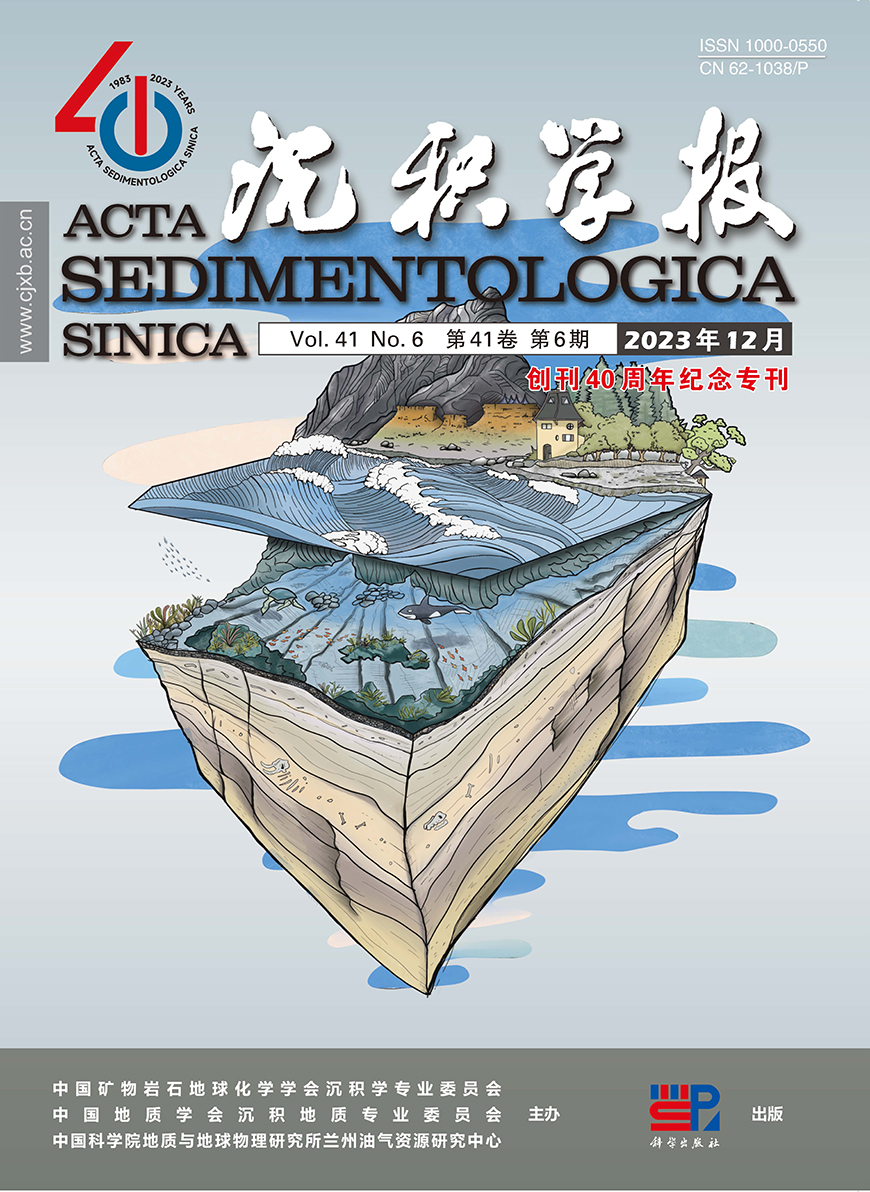


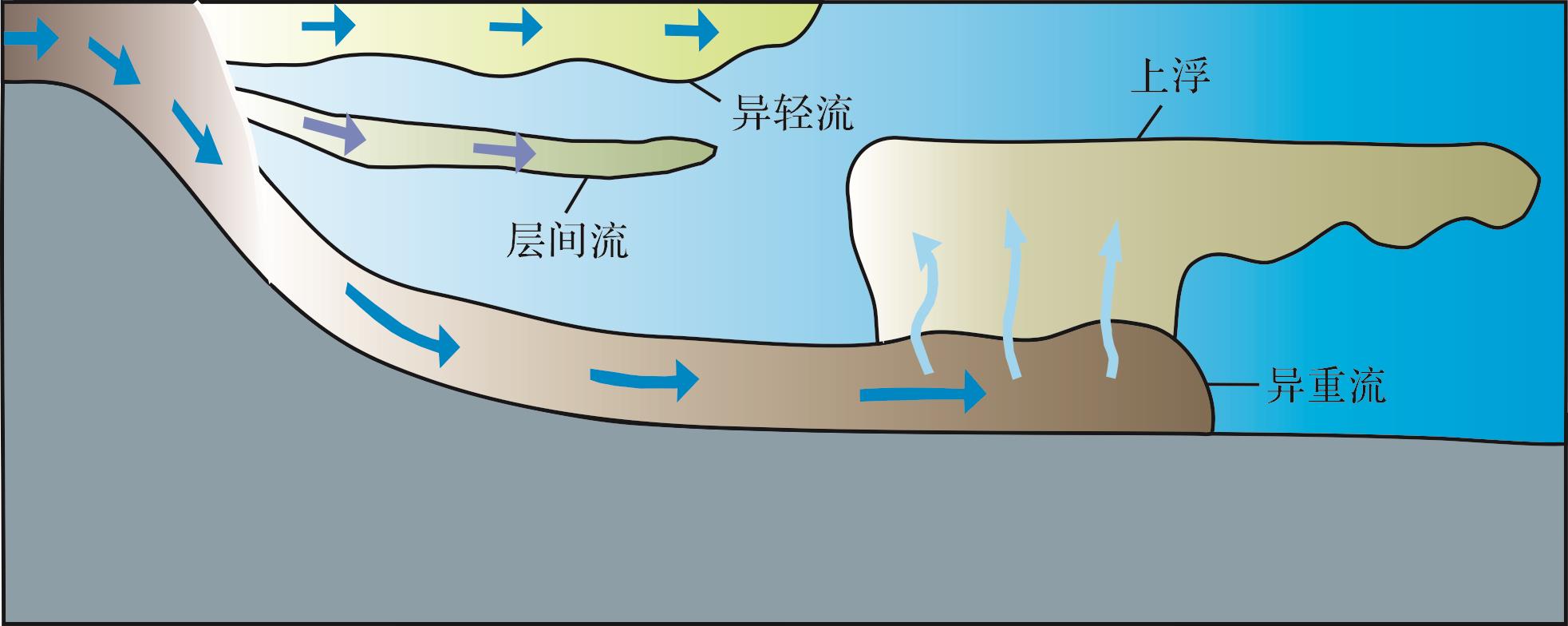





 DownLoad:
DownLoad:
